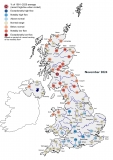Submitted by Michael Eastman on
August did not feel particularly summery for most of the UK; whilst it was dry overall, it was for the most part either unsettled or dull and cloudy. Rainfall in August was below average for the vast majority of the UK (75% of the long‑term average), notably so across the Scottish Highlands and parts of central and eastern England. Wetter than average exceptions were limited to parts of Northern Ireland, eastern Scotland and south-east England. Late August soils were wetter than average in southern England at the conclusion of a wet summer here, but soils elsewhere were generally drier than average (as well as at the national scale). River flows in August were generally below average across most of the UK, notably or exceptionally so across parts of Wales and northern and central England. Groundwater levels generally continued their seasonal recession in all aquifers; they remained in the normal range or above, apart from the Chalk and limestone boreholes in Northern Ireland and South Wales, respectively, in which levels were below average. Reservoir stocks in Scotland, Wales and Northern Ireland were exceptionally low. In the last month, stocks at Haweswater and Thirlmere fell by a fifth of their total capacity. Loch Thom and Daer were a third below their late August average stocks, and Loch Katrine and Loch Thom (as well as Scotland overall) recorded their lowest late August stocks in records from 1994 (eclipsing those of the 1995 drought). Following a dry summer, river flows and particularly reservoir stocks in parts of the north and west are notably or exceptionally low; in late August, Scottish Water stepped up water conservation campaigns to manage demand accordingly. With no strong indication of a wet start to autumn in seasonal outlooks, vigilance will be required in managing water resources in these areas.



